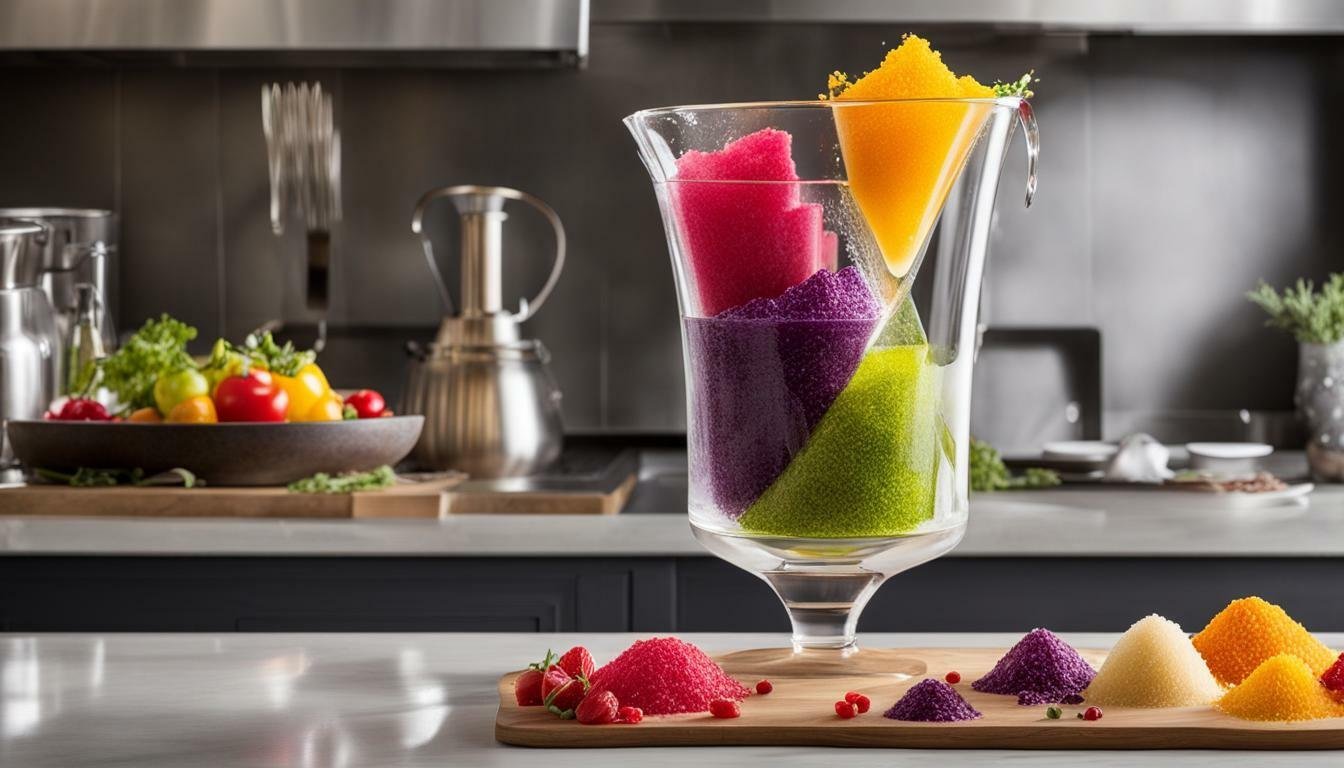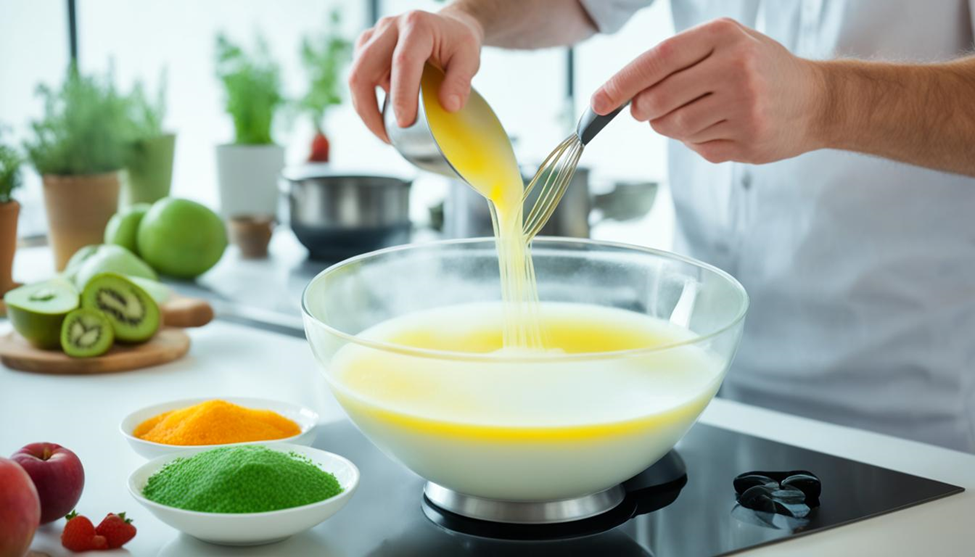
Kitchen Innovations: Unlocking the Power of Culinary Gelling with Sodium Alginate
SUBSCRIBE TO OUR BLOG
Promotions, new products, and recipes.
Are you tired of the same old textures and presentations in your culinary creations? Look no further than sodium alginate, a game-changing ingredient that offers endless possibilities in the kitchen. Derived from brown seaweed, sodium alginate is a natural gelling agent, thickener, and stabilizer that is widely used in the food industry.
In this article, we'll explore the versatility, science, and applications of sodium alginate in both molecular gastronomy and traditional cooking. We'll also provide tips and tricks for working with this ingredient and highlight its health benefits. With sodium alginate, you can unleash your culinary creativity and take your dishes to the next level.
Key Takeaways:
- Sodium alginate is a natural gelling agent, thickener, and stabilizer derived from brown seaweed.
- It offers a wide range of applications in both molecular gastronomy and traditional cooking.
- Understanding the science behind sodium alginate's gelling power is key to using it effectively.
- High-quality sodium alginate can be sourced from reputable suppliers.
- Experimenting with sodium alginate can lead to truly remarkable culinary creations.
What is Sodium Alginate?
Sodium alginate is a naturally occurring compound that is derived from brown seaweed. It is commonly used as a food additive due to its unique properties that make it an excellent gelling agent, thickener, and stabilizer.
The use of alginate as a food additive has been prevalent since the 1920s, and it remains an essential ingredient in the food and beverage industry today. Alginate is extracted from seaweed through a process called alginate production, which involves treating seaweed with an alkaline solution to break down the cell walls and release the alginate.
Alginate food additive has become a staple in many different types of cuisine, from Asian to European to American. Its versatility and stability allow it to be used in a wide range of applications, from creating gels and foams to thickening sauces and soups.
Alginate is a natural product that is safe to consume, making it an ideal choice for chefs and food manufacturers looking for a reliable and effective food additive. With its unique properties and applications, alginate is an essential ingredient in modern cooking.
The Versatility of Sodium Alginate
Sodium alginate is a powerful ingredient that can be used in a wide range of culinary applications. Its ability to form a gel when it comes into contact with calcium ions makes it an ideal choice for creating unique textures and presentations in dishes. With sodium alginate, chefs can create gels, foams, and even spheres known as "caviar". Its versatility makes it a go-to ingredient for both molecular gastronomy and traditional cooking techniques.
In molecular gastronomy, sodium alginate has revolutionized the creation of unique textures and presentations in dishes. Chefs can use sodium alginate to create flavorful gel spheres and encapsulated liquids, adding a touch of innovation to their dishes. Furthermore, in traditional cooking, sodium alginate's ability to thicken sauces and soups, create smooth textures in desserts, and enhance a dish's flavor profile have made it an essential ingredient in many kitchens.
The Versatility of Sodium Alginate
Sodium alginate offers an endless variety of possibilities in the kitchen. It can be used to:
- Create gels, foams, and spheres
- Thicken sauces and soups
- Create smooth textures in desserts
- Enhance a dish's flavor profile
With its versatility, sodium alginate has become a must-have ingredient in both modern and traditional kitchens. Its unique properties allow chefs to create exciting and dynamic dishes that push the boundaries of culinary creativity.
The Science Behind Sodium Alginate's Gelling Power
Sodium alginate has remarkable gelling properties due to its ability to form a gel when it comes into contact with calcium ions. This reaction creates a network of gelatinous strands that give structure and texture to various dishes.
The strength and texture of the gel depend on several factors, including the concentration of sodium alginate, the concentration of calcium ions, and the time allowed for the reaction to occur. Chefs can adjust these variables to create gels with different thicknesses and strengths.
The gelling properties of sodium alginate stem from its molecular structure. Sodium alginate molecules consist of long chains of sugar molecules called polysaccharides. These chains have a negative charge, making them repel one another. However, when calcium ions are present, they create an ionic bond with the sodium alginate molecules, causing them to link together and form a gel.
Understanding the science behind sodium alginate's gelling power allows chefs to harness its potential effectively. By manipulating the variables and experimenting with different techniques, chefs can create innovative culinary creations that push the boundaries of traditional cooking.
Applications of Sodium Alginate in Molecular Gastronomy
Sodium alginate has become a staple in molecular gastronomy, the culinary art that explores the scientific principles behind food preparation and presentation. This versatile ingredient can create unique textures and presentations that amplify the flavors in dishes.
One of the most popular uses of sodium alginate is to create flavorful gel spheres. This process, called spherification, involves transforming a liquid into a solid sphere that bursts with flavor when bitten into. In spherification, sodium alginate is combined with the liquid to be transformed into a sphere, and then dropped into a water bath to solidify. As the spheres float in the water bath, they form a thin skin around the liquid, giving rise to a burst of flavor upon consumption.
Another application of sodium alginate in molecular gastronomy is encapsulation, which involves coating a liquid center with a sodium alginate layer to create a capsule that can be added to a dish. Encapsulation can add both flavor and visual appeal to meals, as diners may not expect a liquid within their food.
Overall, the applications of sodium alginate in molecular gastronomy are vast, and this innovative ingredient continues to inspire new culinary creations. If you're interested in exploring the possibilities of sodium alginate in molecular gastronomy, start experimenting with it in your kitchen today.
The Versatility of Sodium Alginate in Traditional Cooking
While sodium alginate is commonly associated with molecular gastronomy and avant-garde cuisine, its uses extend well beyond those realms. Traditional cooking techniques have also embraced the power of sodium alginate to create a variety of textures, enhance flavors, and improve the overall appearance of dishes. Here are some popular ways of incorporating sodium alginate into traditional recipes:
Thickening Sauces and Soups
Sodium alginate's gelling properties make it an excellent thickening agent for sauces and soups. Unlike other thickeners that require heat to activate, sodium alginate can be added directly to cold liquids, making it a versatile ingredient that can be used in a wide range of recipes. By creating a smooth and velvety texture, sodium alginate can elevate even the simplest of dishes.
Creating Smooth and Creamy Desserts
Sodium alginate can be used to create smooth and creamy textures in a range of desserts. Whether it's a silky vanilla panna cotta or a rich chocolate mousse, sodium alginate can be added to the mix to enhance the texture and mouthfeel of the dish. By giving desserts a velvety and luxurious quality, sodium alginate can transform even the most straightforward recipes into show-stopping creations.
Enhancing the Presentation of Dishes
Sodium alginate's ability to create gels of various shapes and textures can be used to enhance the visual appeal of dishes. By creating gel spheres or other unique shapes, chefs can add dimension and interest to plates. This creates a visually stunning experience for diners, elevating their overall perception of the dish.
By exploring the many ways to use sodium alginate in traditional cooking techniques, chefs can add a touch of innovation and creativity to their recipes. The versatile nature of this ingredient makes it an essential tool in any chef's culinary repertoire.
Finding Sodium Alginate Suppliers and Quality
When it comes to incorporating sodium alginate into your culinary repertoire, it is crucial to source high-quality ingredients. With the increasing demand for this innovative ingredient, many suppliers offer sodium alginate. However, not all suppliers are created equal, and it is essential to find a reliable source.
One way to find reputable sodium alginate suppliers is by researching online. Cape Crystal Brands is a reliable source that you can count on. It is also helpful to read customer reviews to get an idea of the quality of the products and services offered.
Another way to find sodium alginate suppliers is by attending industry events and conferences. These events often provide an opportunity to connect with suppliers and learn more about their products and services in person.
Regardless of how you find your sodium alginate supplier, be sure to ask questions and request samples before making a purchase. This will help you ensure that you are getting the right product for your needs and that it meets your quality standards.
You Can Experiment with Sodium Algiante Right Now.
Try sodium alginate for yourself. Pick up a Cape Crystal Brand package below.
Incorporating Sodium Alginate Into Your Recipes
Now that you understand the versatility and properties of sodium alginate, it's time to put it into practice. Incorporating this ingredient into your recipes requires the right techniques and measurements. The possibilities are endless, from basic spherification to creating unique textures and flavor combinations.
One approach to using sodium alginate is to create a sodium alginate bath. Mix the sodium alginate with water and blend until it dissolves. Let the mixture rest for a few hours to allow any air bubbles to dissipate. Once the water is clear, it's time to incorporate your chosen liquid, such as fruit juice or broth. Using a syringe, gently drip droplets of the mixture into a calcium chloride bath. The calcium ions in the bath react with the sodium alginate to create a gel sphere.
It's essential to use the correct amount of sodium alginate to achieve optimal results. Too little, and the mixture won't gel correctly. Too much, and the texture will become rubbery or slimy. Experimentation is key when working with this ingredient, so don't be afraid to try different techniques and ratios to find what works best for you.
Tips and Tricks for Using Sodium Alginate
Working with sodium alginate can be challenging, but with the right techniques and recipes, you can incorporate it seamlessly into your cooking. Here are some tips and tricks to help you get started:
- Measure accurately: Using the right amount of sodium alginate is crucial to achieving the desired texture and flavor. It is best to weigh the ingredient using a kitchen scale for accuracy.
- Gradually incorporate into liquids: Adding sodium alginate to liquids too quickly can result in clumping. To avoid this, mix small amounts of sodium alginate with water or other liquids, and gradually incorporate the mixture into the main liquid while stirring consistently.
- Use calcium-rich liquids: Calcium ions are necessary for sodium alginate to form a gel. Liquids such as milk, cream, and fruit juices are excellent sources of calcium and work well with sodium alginate.
- Blend with a hand blender: For uniform and smooth gels, blend the mixture with a hand blender or immersion blender. This helps break up any clumps and ensures all ingredients are evenly distributed.
- Experiment with different ratios: The ratio of sodium alginate to liquid affects the texture of the final product. Experiment with different ratios to find the ideal one for your specific recipe.
By following these tips and tricks, you can become a pro at using sodium alginate in your culinary creations.
Exploring the Benefits of Sodium Alginate
Sodium alginate is more than just a culinary gelling agent. This innovative ingredient also offers various health benefits that make it an excellent addition to any diet.
One of the most significant advantages of sodium alginate is its ability to promote gut health. Studies have shown that sodium alginate can act as a prebiotic, promoting the growth of beneficial gut bacteria and reducing inflammation in the digestive tract.
Additionally, sodium alginate can help manage cholesterol levels. Research has suggested that sodium alginate can decrease the absorption of dietary cholesterol, potentially reducing the risk of heart disease.
Incorporating sodium alginate into your cooking not only enhances the taste and texture of your dishes but can also contribute to better overall health.
So why not unleash the full potential of this ingredient and discover the multitude of benefits it has to offer?
Unleash Your Culinary Creativity with Sodium Alginate
If you're a professional chef or an aspiring home cook, you're always on the lookout for innovative ways to elevate your culinary creations. Enter sodium alginate, a powerful alginate food additive that can transform your dishes in ways you never thought possible.
But where can you find reliable sodium alginate suppliers to help you unleash your culinary creativity? Fortunately, a quick online search will reveal various reputable suppliers specializing in this transformative ingredient.
Investing in high-quality sodium alginate is crucial to achieve the best results. Whether you're a professional chef or a home cook, sourcing sodium alginate from trusted suppliers ensures that you have access to top-quality ingredients for all your kitchen experiments.
So, why not take your culinary creativity to the next level? With sodium alginate, the possibilities are endless. From basic spherification to more advanced uses, this ingredient empowers chefs to unleash their creativity and push the boundaries of culinary innovation.
Don't settle for ordinary – discover the vast potential of sodium alginate today and experience the endless possibilities it can unlock in your kitchen!
FAQ
What is sodium alginate?
Sodium alginate is a naturally occurring compound derived from brown seaweed. It is widely used in the food industry as a gelling agent, thickener, and stabilizer.
What are the uses of sodium alginate?
Sodium alginate offers a wide range of applications in the culinary world. It can be used to create gels, foams, and even spheres known as "caviar." It is used in molecular gastronomy as well as traditional cooking techniques.
How does sodium alginate work as a gelling agent?
Sodium alginate has remarkable gelling properties due to its ability to form a gel when it comes into contact with calcium ions. This reaction creates a network of gelatinous strands that give structure and texture to various dishes.
Where can I find high-quality sodium alginate suppliers?
Various suppliers offer sodium alginate for culinary use. It is important to source high-quality ingredients to ensure the best results in your recipes.
How can I incorporate sodium alginate into my recipes?
Discovering the right techniques and recipes to incorporate sodium alginate into your dishes is key to unlocking its potential. From basic spherification to more advanced uses, experimenting with sodium alginate can lead to truly remarkable culinary creations.
Are there any tips and tricks for using sodium alginate?
Working with sodium alginate can be challenging for beginners. However, with the right tips and tricks, you can master the art of incorporating sodium alginate into your recipes. From proper measurement to understanding the ideal conditions for gelling, these insights will help you achieve exceptional results.
What are the benefits of using sodium alginate?
The benefits of using sodium alginate extend beyond its gelling properties. This ingredient offers health benefits, such as gut health promotion and cholesterol management. By incorporating sodium alginate into your cooking, you can enhance both flavors and well-being.
How can sodium alginate unleash my culinary creativity?
Sodium alginate is a true game-changer in the world of culinary gelling. With its versatility, unique properties, and wide range of applications, this ingredient opens up a world of possibilities for professional chefs and home cooks alike. Unleash your culinary creativity by exploring the power of sodium alginate today.
We Invite Your Comments, please:
We would apprecaite hearing from you. Please add your comments below. We will reply to them.
See: The Hydrocolloid Glossary
For further reading:
When and How to Use Sodium Alginate in Your Food Product
Unleash the Power of Sodium Alginate Thickener in Food
Sodium Alginate: The Backbone of Spherification
Magic Spherification with Alginate

About the Editor
About the Chef Edmund: Chef Edmund is the Founder of Cape Crystal Brands and EnvironMolds. He is the author of several non-fiction “How-to” books, past publisher of the ArtMolds Journal Magazine and six cookbooks available for download on this site. He lives and breathes his food blogs as both writer and editor. You can follow him on Twitter and Linkedin.

- Choosing a selection results in a full page refresh.



